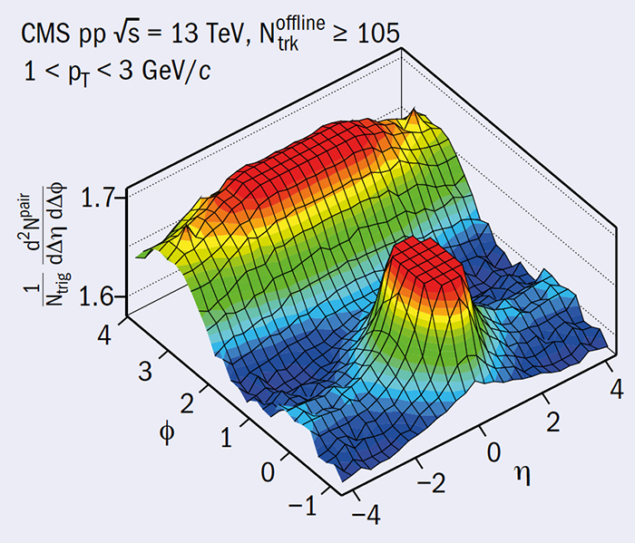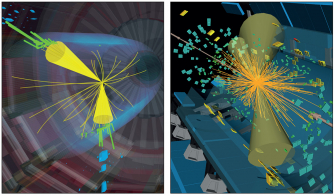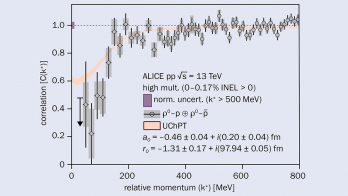
The CMS collaboration has published its first particle-correlation result from proton–proton (pp) collisions at a centre-of-mass energy of 13 TeV. The paper describes the observation of a phenomenon first seen in nucleus–nucleus collisions, and also detected by CMS in 2010 in the initial LHC pp collision run, at a centre-of-mass energy of 7 TeV. CMS later also observed the phenomenon in proton–lead (pPb) collisions at a centre-of-mass energy of 5 TeV per nucleon pair. The phenomenon is an unexpected correlation between pairs of particles appearing in so-called high-multiplicity collisions, which are collisions that produce a large number of particles, i.e. approximately more than 100 charged particles with transverse momentum pT > 0.4 GeV/c within the pseudorapidity region |η| < 2.4. The correlation manifests itself as a ridge-like structure in a 2D angular correlation function.

Following the CMS observation at 7 TeV, interest was expressed concerning the dependence of this phenomenon on the centre-of-mass energy. To more readily address this question, CMS collected a special 13 TeV data set, with an integrated luminosity of 270 nb–1. Here, the average number of simultaneous collisions in a beam bunch crossing was as low as about 1.3, presenting conditions similar to those used for the 7 TeV analysis. Because the effect is expected to appear only in high-multiplicity events, a special trigger was developed based on the number of charged particles detected in the silicon tracker system.
Indeed, about once in every 3000 pp collisions with the highest produced particle multiplicity at 13 TeV, CMS observes an enhancement of particle pairs with small relative azimuthal angle Δφ (figure 1). It therefore appears that charged particles have a slight preference to be emitted pointing in nearly the same azimuthal direction, even if they are very far apart in terms of polar angle, which is measured by the quantity η.
Such correlations are reminiscent of effects first seen in nucleus–nucleus collisions at Brookhaven’s RHIC and later in collisions of lead–lead nuclei (PbPb) at the LHC. Nucleus–nucleus collisions produce a hot, dense medium similar to the quark–gluon plasma thought to have existed in the first microseconds after the Big Bang. The long-range correlations in PbPb collisions are interpreted to result from a hydrodynamic expansion of this medium. Such a medium was not expected in the simpler pp system, and therefore the CMS results from 2010 led to a variety of theoretical models aiming for an explanation.
Remarkably, the new 13 TeV results demonstrate that, within the experimental uncertainties, the strength of the correlation (expressed in terms of associated particle yield) does not depend on the centre-of-mass energy of the pp collision but only on the particle multiplicity. This lack of energy dependence is similar to what is observed for hydrodynamic-flow coefficients measured in nucleus–nucleus collisions at RHIC and the LHC. Compared with the pp results, pPb and PbPb collisions produce correlations that are four and 10 times stronger, respectively, but which are qualitatively very similar to the pp results. The new results from pp collisions extend the measurements to much higher multiplicities compared with those at 7 TeV, and provide the opportunity to understand this curious phenomenon better.








